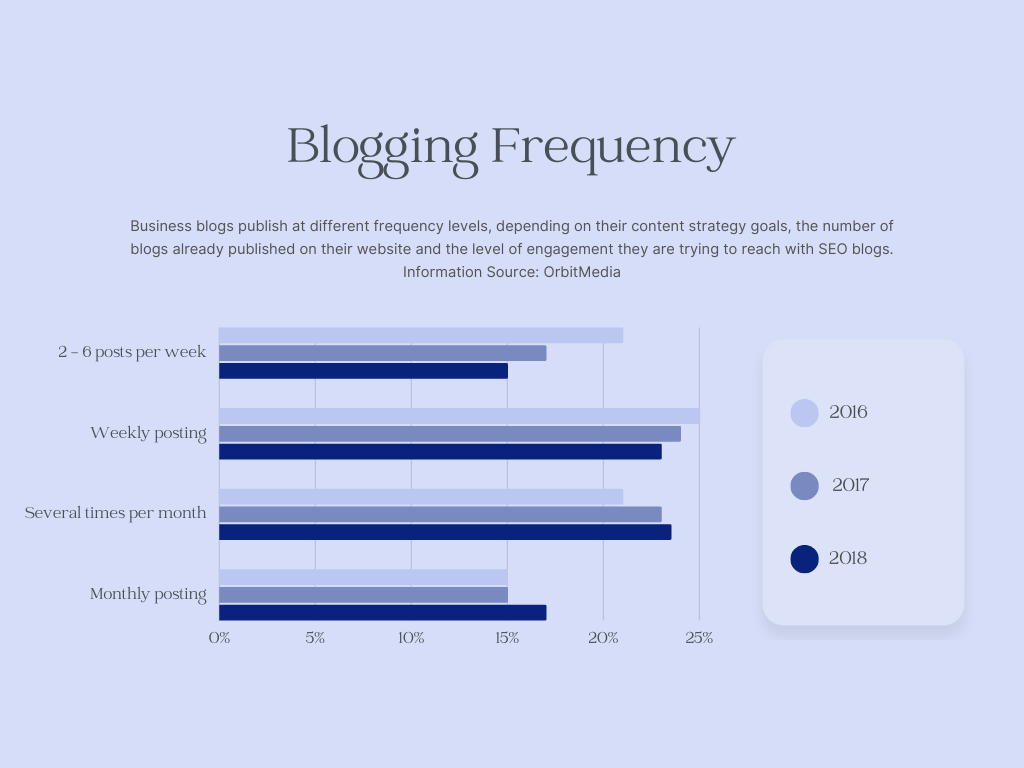If you have a website, the chances are you want visitors. Website visitors are like foot traffic past a shop in a mall. SEO blogs attract website visitors. But all of the content on your site will have them venture in, stick around to browse and hopefully buy.
More visitors should equal more leads or sales.
But it doesn’t always work that way.
So you might be wondering what the point of an SEO blog is, and how many you need. On top of that, your next questions will be ‘How many SEO blogs do I need?’ and ‘How often should I publish new content?
All of these are good questions. And like all good questions, the answer is, it depends…
What an SEO blog should do
In a nutshell, an SEO blog should help your website rank for specific search terms and words. It should position you as knowledgeable in your niche. It does this by providing valuable and helpful information about your product or service.
Google, Bing and other search engines see your content and serve it up to answer searchers’ queries. But that’s only the beginning of what SEO blogging is about. A good SEO blog needs to support a wider content strategy.
Let’s imagine you have a website for selling cars. Your SEO blogs should attract searchers interested in buying and selling cars. Sure, that’ll include an SEO blog or two about how to sell cars and how to buy one. But it should also include related topics. Blogs about car insurance, the best types of cars for various situations, driving in difficult conditions and more.
A good SEO strategy includes blogs about the things your target audience is most interested in.
But that’s not all it does. Content does more than boost SEO. An SEO strategy should fit with a wider content strategy. That content strategy covers distribution, social media marketing, networking, guest posts, email and even list building.
Deciding what you’re wider content strategy needs to do should help you determine how many blogs you need and how often to publish new content.
Creating SEO blogs
Before we get into the frequency and number of blogs you should aim for, a short word on your SEO blog content.
Instead of rattling off three low-quality 500-word blogs a day for the next three months, you’d be better off not writing a word. When it comes to SEO and content strategy, quality trumps quantity – every time.
Poor quality content harms your ranking, the impression you make on visitors and the long-term success of any content strategy you devise. If you have trouble writing blogs or just don’t have the time needed to create great content, engage a professional writer.
Your content needs to be well-written and informative. It should include reliable and helpful information that is up to date. If you have old blogs with out-of-date information, go back and update them. Updating old blogs is a tactic that content marketing geniuses HubSpot use to increase their traffic.
Credible content reflects well on your business. Creating it means paying attention to the links you use and the sources you use to research topics. You don’t have to know everything, but you do have to be 100% sure the information you are providing in your blogs is correct.
Along with quality content, you should aim for consistent content. Consistently publishing your SEO blog content on the same day can help to build your readership.
So, when it comes to your SEO blogs, think quality, credibility and consistency.
The best number of SEO blogs for your website
Before you go writing a bunch of blogs, consider what you have already. Neil Patel says the number of blogs you already have will influence the number of blogs you need to have. Generally speaking, the more SEO blog content you have equals more traffic.
But that’s not the entire story.
An SEO blog is designed to drive traffic. A percentage of that traffic should turn into leads or sales for your business. Otherwise, what’s the point of all that blogging?
B2B businesses that had over 400 blogs tend to get about three times the amount of traffic as similar businesses with half or less that amount of blog content. B2C businesses with 400+ blogs got four and a half times more leads than businesses with a quarter or less blog content.
If you already have 400+ blogs on your website, you should be looking at updating your old content and repurposing content to keep things fresh. SEO is a continual process because there is always someone trying to outrank you.
If you have less than 400 blogs, it’s time to do a content audit. Figure out what you’ve got and what’s missing. Create a content plan that fills the gaps. This gives you a bunch of topics to write about. It also helps you build your content strategically, sticking to the quality, credibility and consistency objectives mentioned earlier.
Blogging frequency
Frequency of your SEO blog publishing should remain consistent. That means not only publishing once per week or month but at the same time each week or month. Content creation is about building credibility with search engines but also interest from readers. Consistently publishing great content does that.
The frequency you settle on depends on a couple of factors – the length of your sales cycle and the goal of your SEO blog (aside from improving your website ranking) are two big ones. If your goal is to simply maintain your online presence, publishing a new blog every two to three months should be fine.
If you want to generate leads from your website, you should be publishing new content more regularly. A once-per-week useful blog can work well. If you are building a readership and your domain authority, two to three times per week is better.

Your blogs should be supported with social media distribution. A guest posting strategy is also worth considering to build your ranking, authority and readership.
Whichever frequency of publication you choose, aim to stick with it for a good while. Gauge your results by checking your website statistics and increase or decrease your frequency accordingly once you have the data to base a decision on.
Ultimately, the number of SEO blogs you need and the frequency you need to publish depends on your business aims. There is no point publishing content on your website willy-nilly. It’s a waste of effort and if you’re paying someone to write it, a waste of money too.
Consider what you want to get from your blogging work and how it can be integrated with a wider content strategy. Once you know where you want to go, it is far easier to map your path to that goal.



Recent Comments